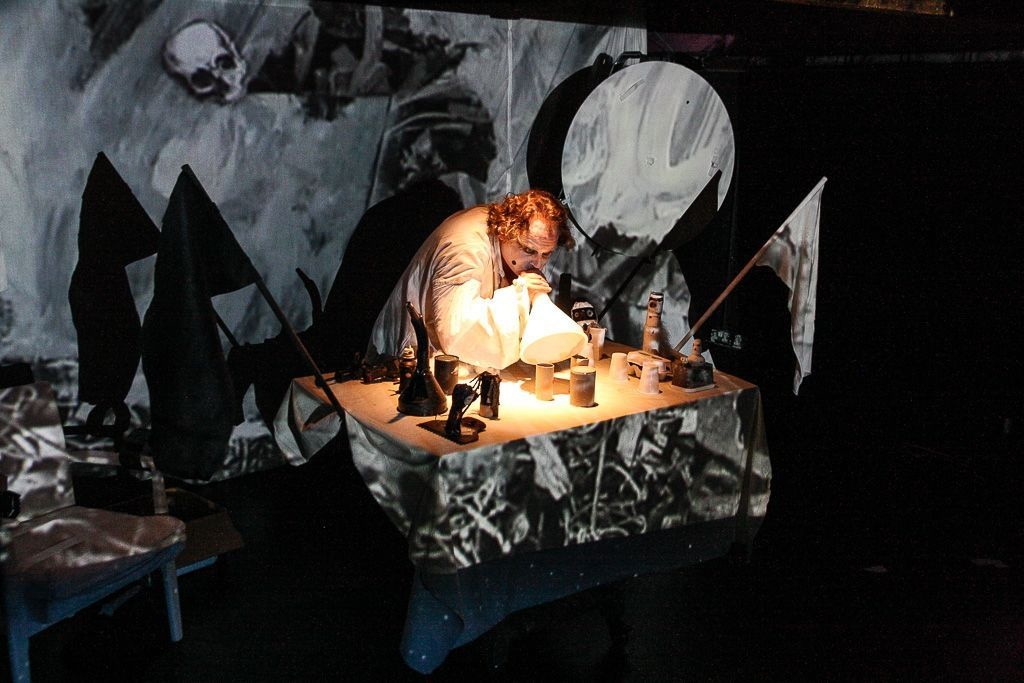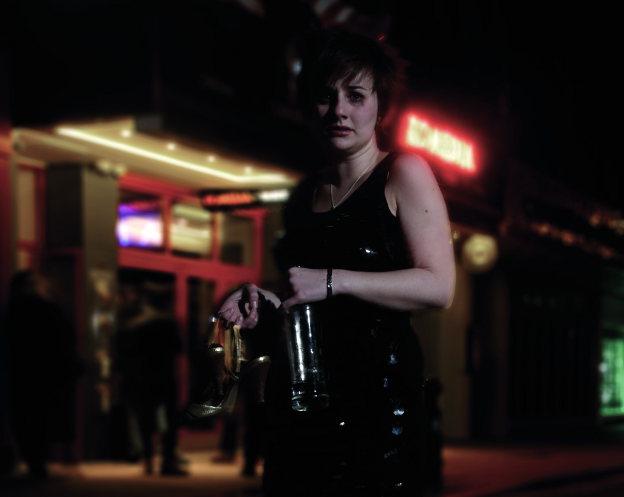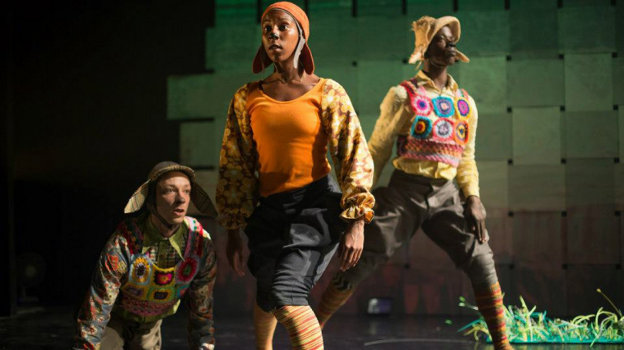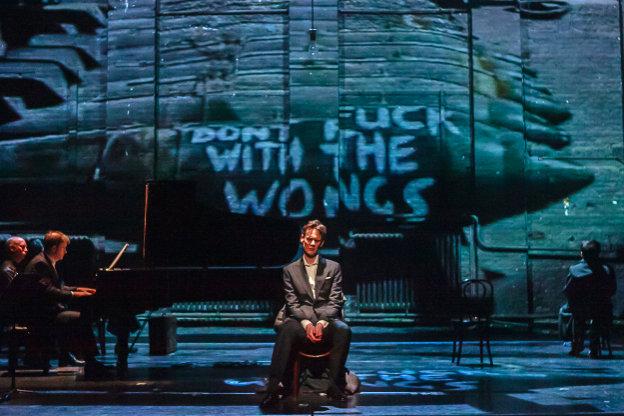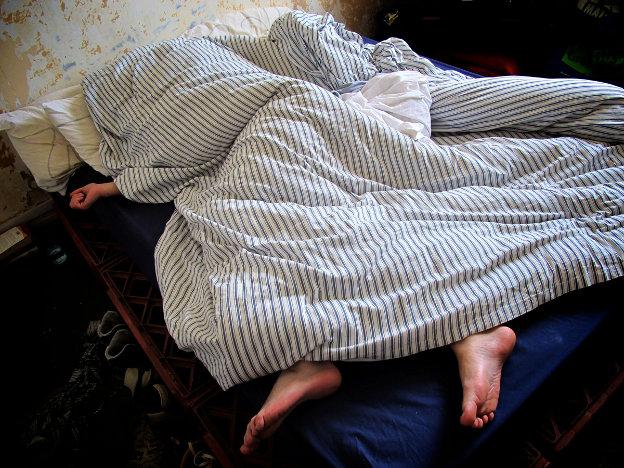 Focusing on physical and mental sickness, as well as social and spiritual sickness, The Basement’s SICK! is an international cross-artform festival exploring the ways our bodies and minds can act against us, the things we can do to regain control, and what lies beneath the surface for some of us – all of us – even when we look ‘normal’. With a diverse programme of live art, dance, digital art, film and debate spread over two weeks, I checked myself in to make a diagnosis.
Focusing on physical and mental sickness, as well as social and spiritual sickness, The Basement’s SICK! is an international cross-artform festival exploring the ways our bodies and minds can act against us, the things we can do to regain control, and what lies beneath the surface for some of us – all of us – even when we look ‘normal’. With a diverse programme of live art, dance, digital art, film and debate spread over two weeks, I checked myself in to make a diagnosis.
SICK! Supper Club, hosted by Bobby Baker, was the festival’s opening event.Supper Club is a regular evening of bite-sized pieces of live art, film and music acts curated by visiting artists or the Basement’s artists in residence. Bobby Baker’s selection included a selection of snappy three-minute performances grown from the Quickfire workshop she had run the previous day. Linked to the idea of being sick, though more to do with the memory of wellness than sickness, these mini-performances, collectively titled Culture Cake, saw each artist share a meal (e.g. a shepherd’s pie or basmati rice) accompanied by a story to do with that dish. These were charming, direct and entertaining, building on Baker’s playful aesthetic of real actions. Another of the pieces presented that evening was Ellie Harrison’s Etiquette of Grief, a solo exploration of experience and grief that starts with the death of the People’s Princess and ends with something much more personal. It feels both playful, funny and moving. Later, a different emotion in Humiliation Piece by Louise Orwin, a hit and miss performance where the audience were invited to truth or dare the performer, generating awkward moments that didn’t quite follow through. The evening’s programme was very entertaining and thought-provoking to a degree, yet palatable in a Supper Club Saturday-night-out-with-your-friends kind of way.
The next day, Sunday afternoon, Under Observation: An Afternoon of Durational Performance and Video was an entirely different kettle of fish: three hard hitting pieces of live art presented in partnership with the Live Art Development Agency. As I arrived at the door, a near hushed reverence heralded what was in store. My first encounter was Mucus Factory by Martin O’Brien. I open a door; a young man is bouncing up and down on a small trampette. Out of the way, in a corner, I find a clear spot of floor space to sit amongst the dozen or so other audience members quiet and still around the perimeter of the small windowless room. I presume this man is getting very hot and sweaty, and collecting something as there are a number of small, clear plastic pots assembled neatly under what appears to be a massage table. I am not prepared for what follows. He lies down and coughs, and… coughs, and coughs, and coughs up mucus which he spits into one of the little pots. Only then it dawns on me that he suffers cystic fibrosis (I hadn’t pre-read anything, so had no expectations). He then proceeds to do other things with his mucus: instead of throwing it away he enjoys it as a source of glamour and pleasure, adding glitter to the mucus, smearing it over his bare flesh, and using it for anal self pleasuring. It is very hard to stomach, particularly at SUCH close proximity. I mean, I could smell the man.
After sensitively finding the appropriate moment to exit, I visit Bleu Remix by Yann Marussich. In this piece, the performer is sealed inside a glass showcase. He is eerily still as gradually, moment by moment, from every pore on his body, he begins to seep and ooze and leak an inky blue fluid. Some of us are centimetres away from him, an arrangement permitted somehow by the clear barrier between us and this human exhibit. How wondrous an organ is the skin. We don’t get to see or acknowledge the job that it does. For the first time ever, I do. Where is this blue sweat coming from? It puzzles and puzzles me. Has he imbibed something? Injected something? It’s like witnessing poison escaping or being repelled out of him – it’s extraordinary, unnerving, fascinating, eerily wondrous. Finally, I watch the video piece Mum by Dutch film-maker and artist Adelheid Roosen. This documentary makes great use of the camera’s potential for profound and unsettling intimacy with its subject as it presents a series of moving portraits of Roosen’s mother with each of her children as they hold her, bathe her, feed her. The proximity of the camera somehow emphasises the strange distance between them opened up by illness. I watched it through twice, as, though it dealt with the disease of Alzheimer’s, the poetics of it completely startled me to tears. This well curated and free afternoon of events left me bothered and disturbed. I was moved and wanted to know more. I hadn’t had such a strong experience at an event for a long time.
Going into Kazuko Hohki’s Incontinental, I knew the subject of the piece was incontinence, and, based on my experience with her previous work, knew that it was most likely going to be a gently humorous show that incorporated some expert medical input. Kazuko began the show in a calm and contained way, explaining the initial meeting and collaboration with the project’s supporter, the Wellcome Trust. Then up onto a projection screen pops two words that I wasn’t prepared for: Faecal Incontinence. Followed by an animation of the Earth, and a song. There was no simulated brown substance and no toilet paper. There was a real doctor, Professor Alastair Forbes from the Gastroenterology team at UCHL, and two performers who, in an energetic jolly cabaret style, aided and abetted tales of how to keep that valuable sphincter muscle healthy, as well as enacting more worrying scenes of stoma surprise. This show is direct and humorous. Sometimes it’s also grim – for instance in the case of the real life story of the young mum who suffers faecal incontinence after childbirth. She cannot even pick her baby up. In the lecture from Prof Forbes, he informs us that 1 in 10 people will suffer faecal incontinence, such as pooing down one’s leg in a supermarket. We see an ultrasound of an anal sphincter muscle and learn just how remarkable it is. Then there’s the Incontinental Flights skit, which gives us a world of no white trousers, no bikinis, no sex and no travel. We are presented with aerobics and disco dysentery (David Bowley & Iggy Poop?!), and we learn of Shloellois, a bacterial overgrowth, and hear how the doctor spends a lot of his time telling his patients to be brave. The real life Prof is at ease on the stage, even when speaking of anal rape – the next moment playing the flute beautifully while a chap plays the tuba like a fart.
How to structure such a show? How to present a subject like faecal incontinence in an entertaining way? This is a topic ordinarily shrouded in secrecy as its sufferers attempt to maintain their dignity. Doctors deal with awful things through humour in order to process gruelling situations themselves. Making taboo a little more accessible, this is brown humour rather than black humour, and goes a long way toward encouraging us to share private things about our own physicality. At times the delivery style is upbeat, almost frivolous; the humour’s important to relieve the taboo. I learnt a few things, was fascinated, and left wondering about how we just don’t talk about poo. We all do it, yet it’s a no-no topic of conversation – unless you’re a toddler, when it’s a top (or should I say, bottom) topic!
In Mad Gyms and Kitchens, Bobby Baker explains that she is a woman and 62 years old. On stage with her are five large cases, the kind you’d imagine a roadie unloading with sound equipment inside. The show is an upbeat personal journey about wending one’s way from illness to wellness. Bobby has been ill with many things and begins a re-imagining of herself in about 1997, showing us a life-size drawing with numbers alongside. She has been diagnosed with personality disorder, mood disorder, anxiety disorder, emotional deregulation, transient psychosis. Bobby tells us she was distressed beyond anything imaginable, and how medication had side effects and made her eat huge amounts, putting on five stone in weight. With an overall sensation of being a mentally disturbed person, at the doctors she would say she felt ill and the doctor would say she ‘had a lot on’. Bobby has also had breast cancer, been through chemotherapy, and has had both knees replaced.
The word / idea ‘disorder’ came in a lot, hence this show’s attempt at an orderly presentation on how to make one’s way to a stronger and sustainable sense of wellness. So, what is well being, and, indeed, what is illness? Mad Gyms and Kitchens is a chatty collection of Bobby Baker’s top tips on wellness, and how to get there. First off, exercise is important. She shows us some floor exercises, then opens the first trunk, which, like a square black egg hatching out its contents, breaks open to reveal a compact gym! Drinking water is also important. Representing nutrition, the next case breaks open to reveal a functioning kitchen! Bobby makes a nutritious cereal and fries up some garlic, because it smells good and homely. Bobby is charming, chatty and amusing. Another box is opened and it’s a bed (rest) and the fourth one is a front room (leisure). These boxes of intrigue are anchor points and something to wonder at during the chat, which can become waffle. The pacing was sometimes a little slow – as visual markers of the structure, I sometimes simply wanted her to get on with it and progress through those enigmatic boxes! Throughout the performance items are attached to ribbons about her neck – a bottle of water to represent exercise, a clove of garlic for nutrition, and so on. Towards the end, her two assistants, wearing white pinnies, become penguins, waddling around to the Hey, Mambo! song. Then, as Bobby says she’s been talking about herself too much, and that we should think about ourselves, the final case is dismantled to reveal the contents of a tea and biscuits emporium. Drawing materials are handed around and we are invited to come up for a cuppa and a nibble and to draw or write our own methods in the quest for wellness. Mad Gyms and Kitchens is upbeat and jolly, and, without being striking or moving, it is, like the biscuits, homely and very digestible. It’s an optimistic show – as it’s not about illness, but about a journey toward wellness (with top tips on how we ourselves can get there).
Finally I attended Mental by ‘outlaw and in-patient, artist-activtist’ The Vacuum Cleaner. Having taken off our shoes and received a slice of carrot cake and a cuppa, we enter the performance space. Sat semi-circle around a white duvet and hillocks of pillows, gradually and curiously, a hand, followed by a length of arm, snakes out from under the covers and turns down the sound system. A face emerges: it’s James (aka The Vacuum Cleaner) who proceeds to tell us his story. With his clear, well paced delivery, we are comfortable and riveted, literally down to earth on cosy cushions, eye to eye, listening to accounts of attempted suicides, of political activism, and of 28 days of self-imposed containment to find a way to manage his distressed condition. There is no explanation as to how, or why; this is what it is – a way through, a journey, that is told and illustrated with files of medical notes and police reports, and photographs and key points, and low points, and crisis points. Incidents are described with such poignant and heartfelt detail that we hang on every word, every angle of James head, and with tea and cake for comfort we want to hear more. As his body emerges further from the bedding, James is dressed in vibrant sapphire blue; as he tells us of his decision to find a way through, we are left with a lot to ponder and consider.
Summing up… SICK! is an important festival. I am well impressed. And this was just the pilot! Most people don’t want to speak of health issues; it’s a taboo, and if you seek help for a mental or emotional health problem there’s a stigma. Or if you suffer a physical condition that remains hidden, that is embarrassing or repellent, concealed from everyday experience, there is such a huge sense of isolation. This festival is an impetus for change: it can help you to see where or how to ask for help, and if you don’t need that intervention then it’s a step toward understanding the unknown, the difficult, the feared. There’s a lot to learn, and a lot to share; a lot to consider, and taboos to be broken and brought out into the open. This brave festival did all of that and more.

